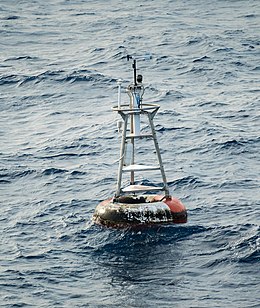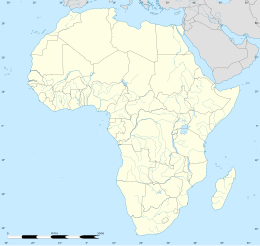|
Null Island
Wikimedia Commons has media related to Null Island. Null Island is the location at zero degrees latitude and zero degrees longitude (0°N 0°E / 0°N 0°E), i.e., where the prime meridian and the equator intersect. Since there is no landmass located at these coordinates, it is not an actual island. The name is often used in mapping software as a placeholder to help find and correct database entries that have erroneously been assigned the coordinates 0,0. Although "Null Island" started as a joke within the geospatial community, it has become a useful means of addressing a recurring issue in geographic information science.[1] Physical locationThe point on the Earth's surface defined as Null Island is located in international waters in the Atlantic Ocean, roughly 600 kilometres (370 mi) off the coast of West Africa, in the Gulf of Guinea.[2] A weather buoy, named the Soul buoy after the soul music genre, was moored at the location.[3] The nearest land to Null Island is a small islet 570 km (354 mi; 307.8 nmi) to the north (4°45′30″N 1°58′33″W / 4.75833°N 1.97583°W) that is part of Ghana. The nearest point on the mainland is Achowa Point[4] between Akwidaa and Dixcove, both in Ghana. The depth of the seabed beneath the Soul buoy is around 4,940 metres (16,210 ft).[5][6] In softwareIn terms of computing and placename databases, the coordinates for Null Island were added to the Natural Earth public domain map dataset[7][8][9] c. 2010–2011, after which the term came into wide use (although there is evidence of it being used previously).[10][user-generated source] Since then, the "island" has, through fiction, been given a geography, history, and flag.[2] Natural Earth describes the entity as a "1 meter square island" with "scale rank 100, indicating it should never be shown in mapping".[7] The name "Null" refers to the two zero coordinates, as null values (indicating an absence of data) are often coerced to a value of 0 when converted to an integer context or "no-nulls allowed" context. The location is used by mapping systems to trap errors.[8] Such errors arise, for example, where an image artifact is erroneously associated to the location by software which cannot attribute a geoposition, and instead associates a latitude and longitude of "Null,Null" or "0,0".[11] As reported in January 2018 by Bellingcat, other data mapped to the location include activity events from the Strava fitness-tracking app, apparently mapped to the location due to users entering "0,0" coordinates to disguise their real locations.[12] Soul buoyThe buoy ("Station 13010 – Soul") was part of the PIRATA system, a set of 17 buoys installed in the tropical Atlantic Ocean since 1997 by the United States, France, and Brazil.[13] Like the other buoys in the system, it was named after a musical genre.[3] It was an Autonomous Temperature Line Acquisition System (ATLAS) buoy that was conical in shape and 3.8 metres (12 ft) high. It was anchored by a cable to the seabed.[6] The buoy disappeared less than a year after its installation, and was replaced in 1998.[3] The buoy was decommissioned in March 2021.[14][15] See also
References
|
||||||||

